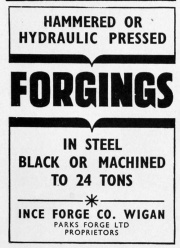Ince Forge Co: Difference between revisions
No edit summary |
No edit summary |
||
| Line 17: | Line 17: | ||
1883 [[Samuel Melling]] of Ince Forge, Wigan, wrote to [[The Engineer 1883/11/02]] (page 339), regarding wrought iron crankshafts | 1883 [[Samuel Melling]] of Ince Forge, Wigan, wrote to [[The Engineer 1883/11/02]] (page 339), regarding wrought iron crankshafts | ||
[[1887 Royal Jubilee Exhibition Manchester]]: The Ince Forge Company, of Wigan, show | [[1887 Royal Jubilee Exhibition Manchester]]: 'The Ince Forge Company, of Wigan, show | ||
excellent specimens of forgings, including an Admiralty pattern marine connecting-rod, and the end | excellent specimens of forgings, including an Admiralty pattern marine connecting-rod, and the end | ||
for a 16 in. hollow built-up crankshaft, both forged from Siemens-Martin ingot steel. Another forging | for a 16 in. hollow built-up crankshaft, both forged from Siemens-Martin ingot steel. Another forging | ||
| Line 24: | Line 24: | ||
we have ever seen, viz., 4 ft. 3 in. long and 12 in. in diameter; it was forged to the correct shape without the usual slotting out of the sweep; by this | we have ever seen, viz., 4 ft. 3 in. long and 12 in. in diameter; it was forged to the correct shape without the usual slotting out of the sweep; by this | ||
means a fibre is secured right throughout the shaft, | means a fibre is secured right throughout the shaft, | ||
webs, and pin, a point which the makers claim to be of great importance.<ref>[[Engineering 1887/08/26]]</ref> | webs, and pin, a point which the makers claim to be of great importance.'<ref>[[Engineering 1887/08/26]]</ref> | ||
1960 Forgings (see advert) | 1960 Forgings (see advert) | ||
The company may have had a connection with [[William Park and Co]] | The company may have had a connection with [[William Park and Co]] | ||
==See Also== | ==See Also== | ||
Latest revision as of 08:59, 22 February 2025






The Ince Forge Company of Park's Forge, Wigan.
1871 Built one locomotive for the South Devon Railway
1877 Business was put in the charge of Thomas Melling and his brothers Samuel and John William (presumably)
1878 Three sets of parts were dispatched to the GWR.
1883 Samuel Melling of Ince Forge, Wigan, wrote to The Engineer 1883/11/02 (page 339), regarding wrought iron crankshafts
1887 Royal Jubilee Exhibition Manchester: 'The Ince Forge Company, of Wigan, show excellent specimens of forgings, including an Admiralty pattern marine connecting-rod, and the end for a 16 in. hollow built-up crankshaft, both forged from Siemens-Martin ingot steel. Another forging is well worthy of notice, viz., a finished wroughtiron crankshaft for the Holt type of single-cylinder marine engine. The crank-pin is one of the longest we have ever seen, viz., 4 ft. 3 in. long and 12 in. in diameter; it was forged to the correct shape without the usual slotting out of the sweep; by this means a fibre is secured right throughout the shaft, webs, and pin, a point which the makers claim to be of great importance.'[1]
1960 Forgings (see advert)
The company may have had a connection with William Park and Co
See Also
Sources of Information
- British Steam Locomotive Builders by James W. Lowe. Published in 1975. ISBN 0-905100-816

